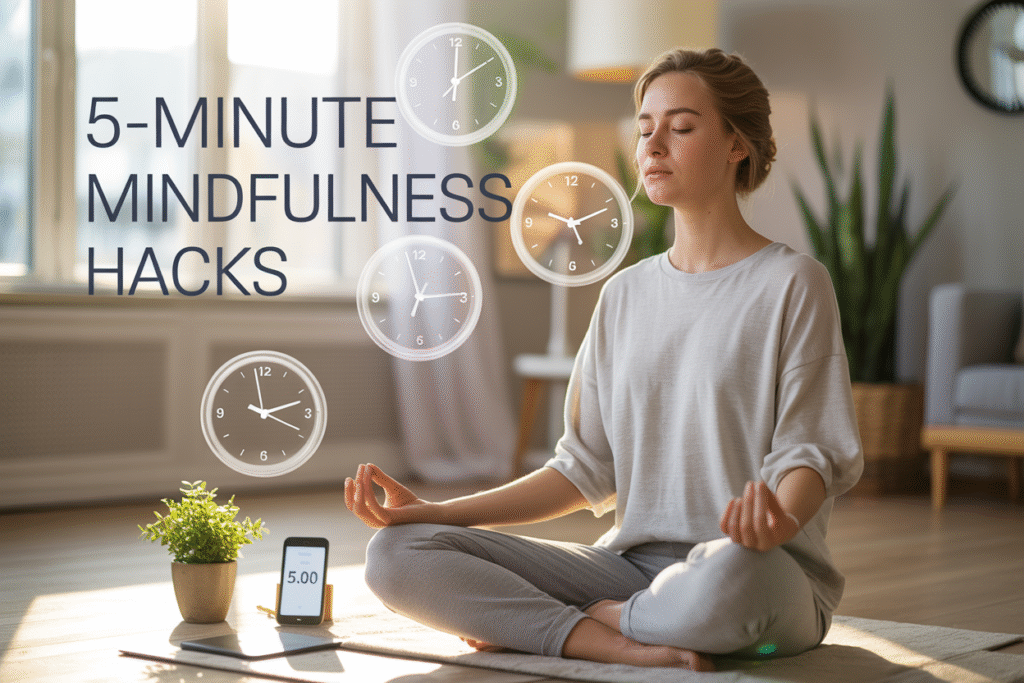In this article
- Quick Physical Reset Techniques for Instant Stress Relief
- Sensory Awareness Practices That Ground You in the Present
- Mindful Daily Activities That Require No Extra Time
- Mental Reset Strategies for Racing Thoughts
- Nature-Based Mindfulness for Quick Calm
- Workplace Stress Busters You Can Do Anywhere
- Advanced Quick Techniques for Deeper Practice
Feeling overwhelmed but don’t have time for a 30-minute meditation? You’re not alone. Busy professionals, parents, and students need 7 mindfulness hacks that work in under 5 minutes to reset their stress levels without derailing their packed schedules.
These quick mindfulness techniques don’t require apps, special equipment, or even stepping away from your desk. Instead, they tap into simple methods that activate your body’s natural relaxation response in moments, not hours.
You’ll discover sensory awareness practices that instantly ground you when your thoughts start spiraling. We’ll also cover workplace mindfulness practices you can do between meetings, plus nature-based techniques that work even if you’re stuck indoors. Each method takes five minutes or less and delivers immediate stress relief when you need it most.
Ready to transform those chaotic moments into opportunities for instant calm? Let’s dive into these proven strategies that fit seamlessly into your real life.

Relief
Quick Physical Reset Techniques for Instant Stress Relief
Use slow rhythmic breathing with extended exhales to activate your parasympathetic nervous system
When you’re feeling stressed, your breathing becomes shallow and rapid. To counteract this stress response, focus on taking long, slow, deep breaths through your belly rather than your chest. Make your exhale longer than your inhale – this simple technique activates your body’s relaxation response and helps flood your system with calming hormones instead of stress chemicals.
Stand up straight to reduce stress hormones and boost confidence
Your posture directly impacts your stress levels and mental state. When you straighten your spine and pull your shoulders back, you’re not just improving your physical alignment – you’re actually reducing cortisol production while boosting confidence-enhancing hormones. This quick physical reset requires no special equipment and can be done anywhere to instantly shift your body out of stress mode.
Unlock the Power of Mindful Breathing: Transform Your Life Now
Sensory Awareness Practices That Ground You in the Present
Check in with your five senses using the 5-4-3-2-1 technique
The 5-4-3-2-1 grounding technique works backward through your senses to anchor you in the present moment. Start by identifying 5 things you can hear around you, then 4 things you can see, 3 things you can touch from where you’re sitting, 2 things you can smell, and finally 1 thing you can taste. This sensory countdown helps redirect your thoughts away from distressing feelings and back to your immediate environment.
Notice what’s physically touching your body right now
Take a moment to focus on physical sensations throughout your body from head to toe. Notice your hair on your shoulders, the weight of your shirt, whether your arms feel loose or stiff, and how your feet feel against the floor. Pay attention to details like whether you’re barefoot or wearing shoes, the texture of fabric against your skin, and the temperature of surfaces you’re touching. These physical awareness practices help ground you in your body’s present experience.

Mindful Daily Activities That Require No Extra Time
Wash your hands slowly as a mindful ritual
Transform your regular hand washing into a mindfulness practice by engaging all your senses. Notice the temperature of the water on your skin, feel the texture of the soap as it creates lather, and observe the bubbles forming and disappearing. Pay attention to the sound of running water and the gentle pressure of your hands moving together. This simple daily activity becomes a grounding moment that brings you fully into the present.
Take three mindful sips of water instead of gulping
Instead of drinking water mindlessly, pause and take three deliberate, conscious sips. Feel the cool liquid entering your mouth, notice its temperature and taste, and observe how it feels as you swallow. This practice transforms a basic necessity into a moment of present-moment awareness, helping you slow down and reconnect with your body’s sensations throughout the day.
Give one song your complete attention while listening
Choose one song during your day and listen to it with complete focus, avoiding all distractions like checking your phone or multitasking. Notice the different instruments, the rhythm, the lyrics, and how the music makes you feel emotionally and physically. This mindful listening exercise turns ordinary background music into a rich sensory experience that anchors you in the present moment.
Take a slow walk at half your normal pace
When walking anywhere, deliberately reduce your pace to half your normal speed and pay attention to each sensation. Feel your feet touching the ground with each step, notice your body’s movement and the rhythm of your breath. Observe your surroundings with fresh eyes – the sun on your face, sounds around you, and the environment you’re moving through, transforming routine movement into walking meditation.
Mental Reset Strategies for Racing Thoughts
Label Your Thoughts as “Planning,” “Worrying,” or “Judging”
When racing thoughts take over, you can regain control by simply categorizing them. As your mind spirals with anxious thoughts, pause and mentally label each thought as “planning,” “worrying,” or “judging.” This technique helps you develop a new relationship with your thoughts by becoming mindful of them instead of entertaining them further.
Name Your Current Emotional State Like a Weather Forecast
Transform overwhelming emotions into manageable observations by describing your mental state as weather conditions. Instead of saying “I’m anxious,” try “I’m experiencing stormy feelings right now” or “There’s some mental fog passing through.” This creates emotional distance and reminds you that, like weather, emotions are temporary and will pass.
Count Your Breaths from One to Ten and Repeat
Your breath serves as an excellent tool for calming your body and mind during mental overwhelm. Practice deep, slow breathing by counting each breath from one to ten, then repeat the cycle. This simple technique tricks your body into thinking you’re relaxing, effectively putting out the flames of anxiety with cool, controlled breaths.
Reinterpret Your Stress Response as Excitement and Energy
Rather than fighting against your body’s stress response, reframe it as excitement and available energy. When you notice physical symptoms of stress like increased heart rate or shallow breathing, consciously tell yourself “I’m feeling energized and ready” instead of “I’m overwhelmed.” This mental shift helps you harness your body’s natural response rather than being controlled by it.
Nature-Based Mindfulness for Quick Calm
Stare Out a Window and Observe Trees, Clouds, or Movement
When you need instant stress relief, simply look outside your window and let your attention rest on natural elements like trees swaying in the breeze or clouds drifting across the sky. Research shows that even viewing nature from indoors can help combat depression and boost your mood, as your brain benefits from reconnecting with the natural world you evolved in.
Look at Pictures of Nature Scenes to Speed Heart Rate Recovery
If you can’t access a window with a nature view, looking at photographs of natural landscapes can still provide meaningful stress relief benefits. Studies indicate that exposure to natural settings, even through images, can reduce symptoms of anxiety and stress while helping your overstimulated mind feel more grounded and at ease in our fast-paced, technology-driven world.

Workplace Stress Busters You Can Do Anywhere
Take three deep breaths before opening emails
Before diving into your inbox each morning, pause and take three intentional deep breaths. This simple practice anchors your attention in the present moment and helps calm your nervous system before potentially stressful communications. Focus on your breath moving in and out of your body, allowing this mindful transition to set a composed tone for handling whatever messages await.
Place your hand on your heart to trigger calming response
When workplace stress peaks, place your hand gently on your heart and notice the physical sensations. This technique helps you become aware of your body’s stress response while activating your parasympathetic nervous system. The simple act of connecting with your heartbeat grounds you in the present moment and can quickly shift your mental state from overwhelm to calm awareness.
Repeat a calming mantra for one to two minutes
Choose a simple phrase like “I am calm and focused” and repeat it silently during stressful moments. This mindfulness technique helps redirect your attention away from racing thoughts and negative mental chatter that can drain your energy. Practice this for just one to two minutes to experience greater balance and acceptance of challenging workplace situations.
Name three things that are going well right now
When stress clouds your perspective, deliberately identify three positive aspects of your current situation. This practice shifts your focus from problems to progress, helping you stay present rather than getting caught up in worry or frustration. Whether it’s completing a task, having supportive colleagues, or simply having a comfortable workspace, acknowledging what’s working well enhances your overall job satisfaction and mental clarity.

Advanced Quick Techniques for Deeper Practice
Do Absolutely Nothing for Five Minutes Without Distractions
Sometimes the most powerful mindfulness practice is the simplest one. Set a timer for five minutes and literally do nothing – no phone, no music, no tasks. Give your body permission to be still and let your mind do what it does. This practice of pure presence can be challenging at first, but it’s incredibly healing and represents mindfulness in its truest form.
Practice Mindful Stretching with Full Attention to Sensations
Transform your regular stretching routine into a mindfulness practice by bringing complete awareness to your movements. Reach your arms overhead, roll your neck, and wiggle your fingers and toes while paying attention to sensations like tightness, release, and relief. Move your body like it’s something to be felt rather than just exercised, turning physical activity into a moment of present-moment awareness.
Recognize Early Warning Signs of Stress Before Full Activation
Developing the ability to catch stress before it fully takes hold is a crucial advanced skill. Notice subtle changes in your body – perhaps tension creeping into your shoulders, your breath becoming shallow, or your jaw tightening. By recognizing these early warning signs, you can intervene with mindfulness techniques before stress reaches its peak intensity.
Use the 5 R’s Framework: Recognize, Refrain, Relax, Recenter, Respond
The 5 R’s provide a structured approach to mindful responding in challenging moments. First, recognize what’s happening in your mind and body. Refrain from reacting automatically to the situation. Relax into the experience rather than fighting it. Recenter your attention on the present moment. Finally, respond mindfully rather than reactively. This framework helps you pause, breathe, and observe what’s going on inside you before taking action.
The beauty of mindfulness lies in its simplicity and accessibility. You don’t need hours of meditation or perfect conditions to experience its benefits. These seven quick techniques prove that even five minutes—or less—can help you reset your stress response, ground yourself in the present moment, and find calm amid chaos. Whether you’re using breathing exercises to activate your parasympathetic nervous system, engaging your senses to break free from racing thoughts, or incorporating mindful awareness into daily activities you’re already doing, you have powerful tools at your fingertips.
Start small and be consistent. Pick one or two techniques that resonate with you and practice them regularly throughout your day. Remember, mindfulness isn’t about perfection—it’s about noticing what’s happening right now and giving yourself permission to pause. As you build these micro-moments of awareness into your routine, you’ll discover that managing stress and finding presence doesn’t require dramatic lifestyle changes, just brief intentional moments that can transform even your busiest days.


